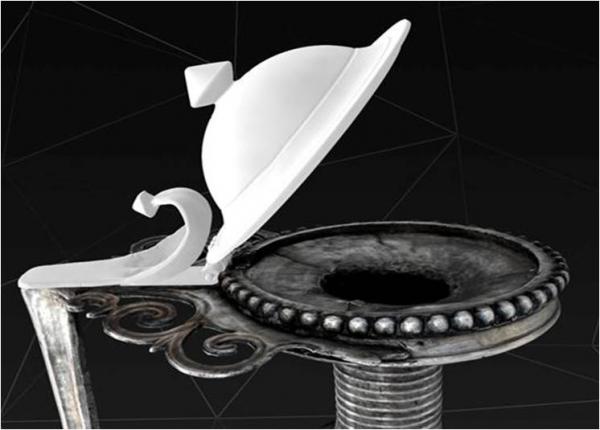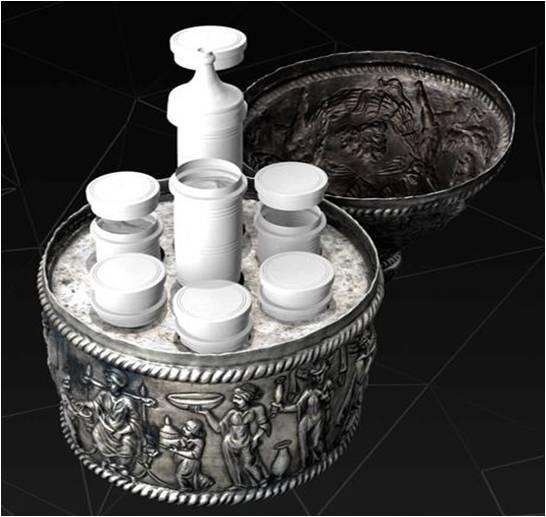Undiscovered objects
The find known as the Seuso treasure is probably not complete. Judging by other similar treasure finds and banquet representations, it could have included further pieces, such as a stand, small tableware and cutlery. If they really did exist, their current location is unknown.
At present the Seuso treasure comprises altogether 15 pieces. However, comparing it with silver treasure of a similar age and composition it can be presumed that the set must have originally included far more objects. We have partial information about two further large platters which have been connected to the Seuso treasure. One of the currently hidden platters is decorated with a Christogram, the other portrays Constantine I (the Great) and his sons. An eyewitness report of someone who saw the find soon after its discovery refers to the larger size of the treasure. According to that, the artefacts were hidden in two cauldrons. Of those only one and the objects presumably found in it are known today. An undated letter which came to light in 2007 and which had been written by Halim Korban, a Viennese art dealer of Lebanese origin, who passed on the Seuso treasure, may shed light on the content of the other cauldron. In that he offered for sale 187 gilded silver spoons, 37 silver cups and 5 plates as further parts of the treasure. The total of 229 further silver objects would in fact make the banquet set more complete. Yet, apart from their number and assumed existence, nothing is known about these objects because the then prospective buyers withdrew from the purchase. In so far as they exist, their location is unknown at present. Should these silver objects ever appear only a thorough examination could determine whether they belong to the treasure or not.
Contrary to the above, the eyewitnesses from Polgárdi estimated the number of objects included in the find to be about 40, but perhaps this figure referred to the larger objects or those which they themselves had seen. We know that the person who discovered the find gave away and sold several pieces. However, they are either lost or could still be found somewhere but their owners do not recognize their significance or are afraid of bringing them forward. Yet they could be crucial evidence for the finds having been discovered in Hungary.
That would be so in the following instances:
• if the name Seuso appeared on a newly found silver object;
• if another piece that could make up a pair with a vessel of the Seuso treasure turned up, for example if it were identical in its form and decoration to one of the ewers;
• if a missing part of one of the presently known objects were found.
Traces of solder can be seen on the side and lid of the perfume casket. This shows that it used to have a locking device and hinge, as well as a hanging chain and three loops to hold the chain. The silver pots, which used to be stored inside, are also missing. Judging by similar finds, the pots could possibly be of a cylindrical shape with a circular flat or conical lids. Their size can be reconstructed by the interior plate of the casket. Based on the circular cut-outs in the plate, the diameter of the pots was probably 4 centimetres, the height of their lower part based on the position of the plate as compared to the bottom of the casket could have been 10-12 centimetres.
The lids of several ewers (Dionysiac Ewer and Geometric Ewers) and thumb-piece (Animal Ewer and Geometric Ewer A) are absent. For example, if someone were to hand in a hinged lid that matched one of the ewers both in its style and size, it would be direct proof that it belonged to the Seuso treasure. The ewer lids are circular and fit in the palm of a hand (approx. 7-9 centimetre in diameter). They are silver and curved hemispherically towards the centre, and they were joined to the handle of the ewer with a hinge. The thumb-piece of the Animal Ewer was probably similar in shape and decoration to the existing thumb-pieces.




